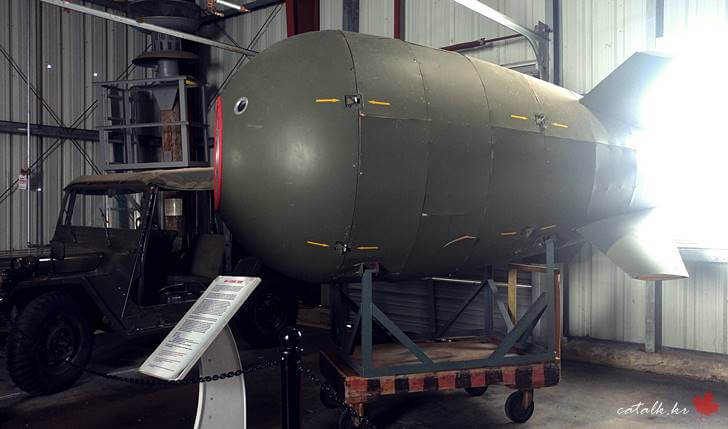American Mark-4 nuclear bomb
The Mark-4 Atomic Bomb
The MK-4 Atomic Bomb was the first mass-produced nuclear weapon in the U.S.arsenal. Over 550 were built. This air-dropped weapon could only be detonated in an air burst, well above ground level, for maximum destruction of a city. The first bomb entered the arsenal on 19 March, 1949, and the last was retired in May 1953.

The the Mark-4 bombs were first deployed in Guam
It was the first nuclear weapon to be deployed overseas since World War II, when nine were sent to Guam during the Korean War in August 1950. The nuclear cores were later sent in April 1951, and plans were made to drop the bombs on seven Chinese and two Soviet cities in the far east by the 43rd Bomb Wing.
Features of the Mark-4
The MK-4 had a removeable core which could be put into the bomb during flight. A well-trained weaponeer could insert the core and ready the bomb for combat use in less than 30 minutes. The uranium or plutonium core was inserted by removing the flat nose palte of the bomb, disconnecting the detonator cables, removing two destonators, removing a polar cap covering the forward hemisphere of high explosives, removing the outer and then the inner tapered high explosive lenses, and pulling out a cylindrical plug made up of the aluminium pusher and the natural uranium tamper. This revealed the space for the core, an 11cm diameter sphere of radioactive materials coated in nickel. The four high explosive lenses weighed about 156kg; the pusher-tamper 4kg; and the core nearly 6kg.
Design and fabrication of the Mark-4
The unclear bomb components were designed by the Los Alamos Laboratory, and the exterior bomb shape was built by American Car & Foundry Company.
The Mark-4 Tests
These versions of the MK-4 were detonated in tests X-ray, Yoke and Zebra of Operation Sandstone in early 1948. The X-ray device used a composite uranium-plutonium Type B levitated core. This meant 2.5kg of plutonium and 5kg of uranium. The explosion only released the energy of about 35% of the plutonium, and around 25% of the uranium. It wasd not an efficient use of the raw materials. However, the X-ray core produced the largest explosion in the world up to that date. The Zebra device used only highly enriched uranium in the levitated core.
10 fast facts about the Mark-4 atomic bomb
- Type: Air-dropped Nuclear fission weapon
- Place of origin: United States
- Used by: United States Air Force(USAF)
- In service: 1949-1953
- No. built: 550
- Length: 3.3m
- Width: 1.54m
- Diameter: 60 in(1.5m)
- Weight: 4,900 to 4,940kg
- Explosive Yield: 18-22-37kt(same as bomb used on Nagasaki)
Canada’s Cold War Museum, Diefenbunker

I could see the bomb as soon as I opened the doors of Canada’s Cold War Museum. The Diefenbunker was an underground bunker designed to withstand the force of a nuclear blast. It was built in Carp, Ontario, during a peak in Cold War tensions between 1959 and 1961. It was originally built by the government to house Canadian leaders during a nuclear attack but now serves as Canada’s Cold War Museum. The bombs exhibited was built by Russ Gray, The Scenic Route Inc. (Edmonton) in 2003, and used in the documentary film.



